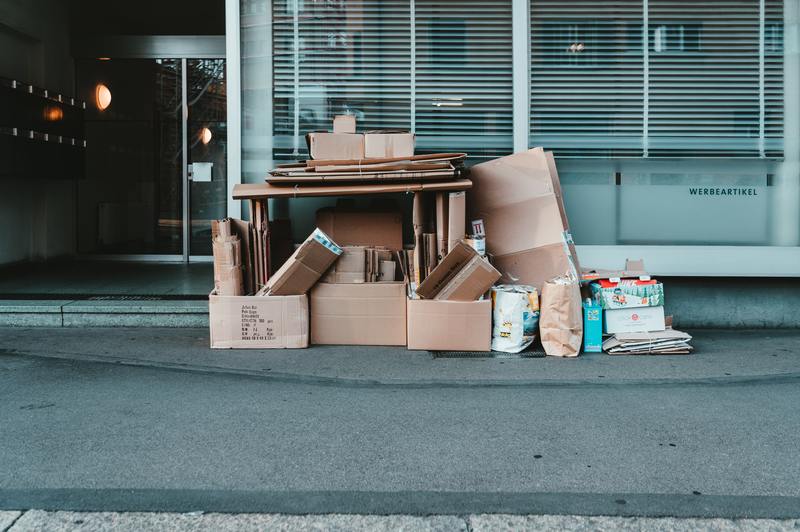The most common procedure on how to pull apart water damaged cardboard is to air dry the material. This method ensures that there will be no further damage inflicted on the item. Pulling it apart too soon is a sure way of ruining your salvaging efforts.
This content will also discuss tips on how to prevent your cardboard from being wet in the first place. Other methods such as freezing and dehumidification will be tackled as well.

Ways to Pull Apart Water Damaged Cardboard
Since cardboards are made from trees, everyone wants to use them to their maximum lifespan. Learning how to save water-damaged cardboard is essentially a small contribution to environmental conservation. Below are the ways on how to do just that and safely pull apart water-damaged cardboard.
1. Air-drying
Air-drying is the most reliable method of drying wet cardboard. Before pulling apart the water damaged cardboards, it needs to be dry as much as possible. Air-drying can do just that while providing security and protection to the cardboards.
Another advantage of air-drying is that it is easy to do. Hang the wet cardboards in clotheslines and secure them in place with clips. Alternatively, place the soaked materials on a table or desk, where humidity is low and the sunlight hits the items directly.
Once the cardboards are thoroughly dried, you may start peeling each sheet apart. If the sheets stick, that means it is still not dried enough yet. Give it some time since complete drying typically takes several weeks to accomplish.
2. Freezing
The drawback of air-drying is you need the weather to cooperate. If you are situated in a place where monsoons come aplenty, air-drying is not feasible. Fret not, because freezing got your back.
In its liquid state, water can wreak havoc on paper materials. Converting water to ice immobilizes the water molecules so you can buy some time before air-drying the wet materials.
This method may draw some comparison with freezing food products. Even if a food product has a high moisture content, if its water activity (the amount of water available for microorganisms) is low, microbial spoilage will slow down. Freezing the water makes it unavailable to microorganisms, or in our case, paper destruction.
This method needs to be done at the earliest possible opportunity. By doing so, you can expect to have the least amount of twisting amongst all methods. Freezing is also the method of choice when dealing with a considerable quantity of wet cardboard materials.
3. Dehumidification
Humidity is defined as the quantity of vapor in the air. The higher the amount of water vapor in the air, the higher the humidity. The higher humidity, the wetter it feels on the body.
Dehumidification involves transferring of moisture from an area of high water content to a place of lower water content. To give a concrete example, let us study the case of wet cardboard.
With a dehumidifier, the moisture in the air where the cardboards are located is lowered. The machine ‘sucks’ the water in the surroundings.
Consequently, the lower amount of water in the air draws the moisture in the cardboards out. That means the water in the cardboards goes to the air, which then goes to the dehumidifier.
Unlike the first two methods, dehumidification is relatively quick, and complete drying can be achieved in a matter of days, depending on the initial wetness of the materials. A dehumidifier can be rented from a nearby shop, or you may hire a professional service provider to do the process.
How to prevent water damaged cardboards
Implementing some proactive measures will do the trick to save you from the hassle of all these drying techniques. Below are some of the materials you can use to prevent water-damaged cardboards.
Laminated covers
Laminated covers are waterproof sheets that protect the contents it houses. One needs to cover their package completely — top, bottom, all sides — so their efforts will not go to waste. A single air pocket where water can seep through will make these protective materials useless.
Cling wraps
These ever-reliable plastic sheets are not limited to kitchen functions. Larger shrink wraps are being used in the logistics sector for a long time to hold cargoes in pallets. The second purpose of these materials is to protect the shipped items from water.
Bubble wraps
Similar to cling wraps, bubble wraps hold cargoes in place and protect the items from moisture. In addition, it provides extra protection as a cushioning layer, protecting your goods from bumps during transport.
Rubber coating
Rubber-treated shields are available in hardware stores and some paint shops. The covering is coated with rubberized material and then dried. Water from rain and other sources cannot penetrate this shield, but the goods must be adequately secured without air pockets like laminated covers.
Conclusion
The humble cardboard boxes have made significant leaps in their utilization. Big logistics companies rely heavily on these reliable materials. The rise of innovative platforms like Amazon further increased the demand for these items.
Cardboards have become integral in everyday life of each citizen. Therefore, one must know how to pull apart water damaged cardboard to salvage and possibly reuse these invaluable resources. When recycling these items, care must be taken, as heavily wet cardboards will cause more harm than good in recycling facilities.
